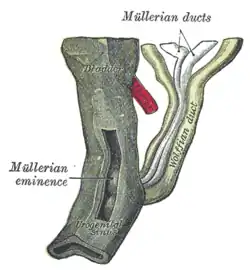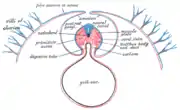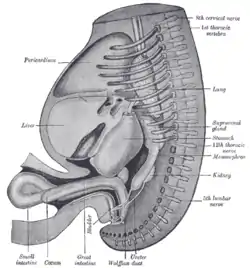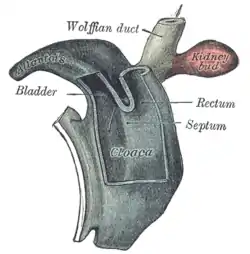Mesonephric duct
The mesonephric duct (also known as the Wolffian duct, archinephric duct, Leydig's duct or nephric duct) is a paired organ that forms during the embryonic development of humans and other mammals and gives rise to male reproductive organs.
| Mesonephric duct | |
|---|---|
 Urogenital sinus of female human embryo of eight and a half to nine weeks old. | |
| Details | |
| Carnegie stage | 11 |
| Days | 28 |
| Precursor | intermediate mesoderm |
| Gives rise to | vas deferens, seminal vesicles, epididymis |
| Identifiers | |
| Latin | ductus mesonephricus; ductus Wolffi |
| MeSH | D014928 |
| TE | duct_by_E5.6.2.0.0.0.4 E5.6.2.0.0.0.4 |
| Anatomical terminology | |
Structure
The mesonephric duct connects the primitive kidney, the mesonephros, to the cloaca. It also serves as the primordium for male urogenital structures including the epididymis, vas deferens, and seminal vesicles.
Development
In both male and female the mesonephric duct develops into the trigone of urinary bladder, a part of the bladder wall, but the sexes differentiate in other ways during development of the urinary and reproductive organs.
Male
In a male, it develops into a system of connected organs between the efferent ducts of the testis and the prostate, namely the epididymis, the vas deferens, and the seminal vesicle. The prostate forms from the urogenital sinus and the efferent ducts form from the mesonephric tubules.
For this it is critical that the ducts are exposed to testosterone during embryogenesis. Testosterone binds to and activates androgen receptor, affecting intracellular signals and modifying the expression of numerous genes.[1]
In the mature male, the function of this system is to store and mature sperm, and provide accessory semen fluid.
Female
In the female, with the absence of anti-Müllerian hormone secretion by the Sertoli cells and subsequent Müllerian apoptosis, the mesonephric duct regresses, although inclusions may persist. The epoophoron and Skene's glands may be present. Also, lateral to the wall of the vagina a Gartner's duct or cyst could develop as a remnant.
Function
Sexual differentiation
History
It is named after Caspar Friedrich Wolff who described the mesonephros and its ducts in his dissertation in 1759.[2]
Additional images
_(20754316592).jpg.webp)
 Diagram of a transverse section, showing the mode of formation of the amnion in the chick.
Diagram of a transverse section, showing the mode of formation of the amnion in the chick. Reconstruction of a human embryo of 17 mm.
Reconstruction of a human embryo of 17 mm. Cloaca of human embryo from twenty-five to twenty-seven days old.
Cloaca of human embryo from twenty-five to twenty-seven days old. Tail end of human embryo thirty-two to thirty-three days old.
Tail end of human embryo thirty-two to thirty-three days old. Tail end of human embryo; from eight and a half to nine weeks old.
Tail end of human embryo; from eight and a half to nine weeks old.
See also
References
- Hannema SE, Print CG, Charnock-Jones DS, Coleman N, Hughes IA (2006). "Changes in gene expression during Wolffian duct development". Horm. Res. 65 (4): 200–9. doi:10.1159/000092408. PMID 16567946. S2CID 2444520.
- synd/2845 at Who Named It?
External links
- How the Body Works / Sex Development / Sexual Differentiation / Duct Differentiation - The Hospital for Sick Children (GTA - Toronto, Ontario, Canada)